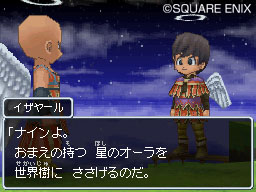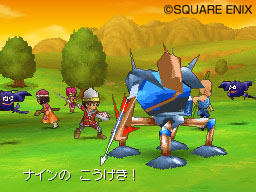Overview
Dragon Quest IX: Sentinels of the Starry Skies began development in 2006 as the first primary entry in the Dragon Quest franchise to debut on a handheld system. After several delays, the title debuted on July 11, 2009 in Japan and quickly sold over two million copies within days of its release. Released by Square Enix in Japan, it was published by Nintendo in North America and Europe.
Plot
 The protagonist is listening to Aquila, his mentor.
The protagonist is listening to Aquila, his mentor.The protagonist is a Celestrian, or guardian angel, recently appointed to a small village called Angel Falls. Celestrians are charged with protecting and helping humans, and in doing so they receive Benevolessence crystals to take with them back to their Observatory, where they view the mortal realm. The gathered Benevolessence is presented to Yggdrasil, the Tree of Life, as an offering to the Almighty in the hopes that one day they may return to his presence.
However, all is not peaceful at the Observatory. During a ceremony where Yggdrasil finally bears fruit, there is a disaster that changes the course of the protagonist's life forever. The entire human race is put in danger, and the Celestrians are held back from reaching their goal of returning to the presence of the Almighty.
The protagonist gets thrown off the Observatory and regains consciousness in Angel Falls without a halo or wings. It becomes the protagonist's task to regain his or her Celestrial wings and halo and then return to the Observatory. The protagonist will do this by accomplishing good tasks and gaining benevolessence from mortals. After returning to the Observatory, the protagonist discovers that all Celestrians have been dispatched across the world to recover fyggs, the fruits of Yggdrasil, which were scattered after the attack on the Observatory.
Gameplay
 DQ IX retains the turn-based combat of its predecessors
DQ IX retains the turn-based combat of its predecessorsDragon Quest IX originally was going to use a real-time battle system which would skew the game-play towards a more action-oriented pace. This has been changed to a turn-based RPG, which is more traditional to the series. A drastic addition to the game is the ability to play cooperative multiplayer for up to 4 players locally. Players can also customize the appearance of their characters, controlling such things as the height, weight, face, hair and even costumes of their heroes.
Alchemy
After progressing through the game alchemy will become available with the use of Krak Pot, an animated alchemy pot left at an inn as payment by an impoverished alchemist. Krak Pot will allow you to use two different methods of blending: Use A Recipe, taking a method of combination that you have input before of have learned about, or Try Your Luck, this will allow you to mix items together and hope that they will create a useful item but if nothing can be made Krak Pot will inform you and give your items back. There are many categories of items that can be made such all types of weapons, armour, accessories and items to be used in battle. All of the combinations that can be made using Krak Pot are kept in the Alchenomicon.
Battles
Battles are fought in the traditional RPG manner but instead of being first person like the previous Dragon Quest games on DS, it opts for a more Final Fantasy-way of battles. A combo system is also present, when two or more identical attacks are made on the same opponent, the damage increases by a multiplier (1.2x for 2 hits, 1.5x for 3 hits and 2.0x for 4 hits). Experience that is earned during battles is scaled depending on the level of the characters.
Characters
In part due to Dragon Quest IX's design as a multiplayer game, party members consist entirely of characters created and chosen by the player. Each character can be customized, both during creation and throughout the game. Changeable features during creation include gender, hair style and color, eye shape and color, body type, skin tone, and class. Customizing a character continues into the main game with weapons and armor, now visible during battles and while exploring the world map and towns. Weapons and armor slots include one weapon, a shield, a helmet, body armor, leg armor, gloves, boots, and accessories (rings or amulets, for example).
DQVC
At a certain point in the game, the player will be allowed to access the DQVC. The DQVC is an online service that wirelessly downloads items to the player. These items are put in an offline, in-game store that the player can access. The player does not need to connect online to purchase items in the store, only to download them. The player can download new items once per day. The items are randomized and most are not unique to the store. They might be common items that the players could easily purchase in most in-game stores or they might be rare drops that are harder to find. All items in the store are purchased with in-game currency. Also, the DQVC will occasionally provide new NPCs to chat with in the royal suites and new quests to find. The NPCs that appear in the suites are major characters from previous entries in the Dragon Quest series.
Grottoes
At a certain point in the game, the player will be given their first treasure map. The treasure map shows a zoomed-in portion of the map with an X on it. If the player is able to locate the location of the X, they'll discover a grotto. There are over a hundred of these grottoes. They contain multiple levels, random treasure chests, and monsters for the player to fight. At the end of each grotto, there's a boss that will drop another treasure map and sometimes a rare item. In addition to regular grottos, the player will eventually gain access to special grottos, wherein a "Legacy Boss" lies in wait. These legacy bosses are major antagonists from previous entries in the series and each can be levelled up on defeat, up to a maximum of 99, leading to a higher amount of challenge.
Quests
In addition to the main quest, Dragon Quest IX allows you to take on various side quests. You can only have eight side quests active at one time, but you can cancel any of them whenever you want to make room for new ones. Quests are given by numerous NPCs scattered throughout the world. Many quests are only available after certain requirements are fulfilled: after an event takes place, after certain quests are completed, after certain level requirements are met, etc. The quests are varied and they could be as simple as having to collect an item or they might need you to kill a number of monsters in very specific ways. There are over a hundred quests to find and more can be downloaded through the DQVC.
Vocations
One of the most significant gameplay features of Dragon Quest IX is the ability to choose the vocation for every character in your party. Your main character starts off as a minstrel, and the other characters you recruit are initially stuck with whatever vocation they started as. After a certain point in the game, the player is allowed to change the vocation of every party member. Only a few vocations are available at the beginning but more can be unlocked through quests. When a player changes vocations, they retain all previous abilities but level, statistics, and magic do not carry over. The player can change back to an old vocation and retain everything they had, however.
There are twelve vocations:
- Minstrel - Your starting class. A jack-of-all-trades that can attack, use magic and heal. They do not, however, particularly excel in any one area. They can use swords, whips, fans and shields.
- Warrior - Unlocked by default. Part tank, part physical attacker, warriors can dish out physical damage and protect allies. Warriors can wield swords, knives, spears and shields.
- Mage - Unlocked by default. The mage slings magical spells, able to do great damage to one or multiple targets. Mages use wands, whips, knives and shields.
- Priest - Unlocked by default. Priests specialize in healing allies. Priests can hold spears, staves, wands and shields.
- Thief - Unlocked by default. The thief is very fast and can steal items from enemies. They can also detect treasure and poison enemies. Thieves can use swords, knives, claws or engage in fisticuffs.
- Martial Artist - Unlocked by default. An interesting alternative to the warrior, the martial artist is fast and hits hard, but doesn't have the defensive protection of the warrior. They do have lots of health however. The martial artist can wield claws, fans, staves, or just beat enemies with their fists.
- Armamentalist - Unlocked via quest. Part warrior, part mage, armamentalists are magical fighters, specializing in debuffs and status effects. Their weakness is lack of physical toughness. Armamentalists can use swords, bows, wands and equip shields.
- Gladiator - Unlocked via quest. The gladiator takes the strength of the warrior and ramps it up, at the cost of physical defense. Gladiators can use swords, axes, hammers or just their fists.
- Paladin - Unlocked via quest. Paladins are pure defense, protecting and healing allies. Paladins wield spears, hammers, wands and shields.
- Ranger - Unlocked via quest. Survivalist experts and nature lovers, rangers can fight at range or in-close equally well. They can use bows, boomerangs, axes or just plain fists.
- Sage - Unlocked via quest. Sages are equal mage and priest, casting spells and healing friends. They have more MP than any other vocation. Sages carry bows, boomerangs, wands and shields.
- Luminary - Unlocked via quest (post-main story only). Like the minstrel, the luminary is a jack-of-all-trades, with an interesting twist of being very high in charm. Luminaries may use boomerangs, fans, whips and shields.
Log in to comment